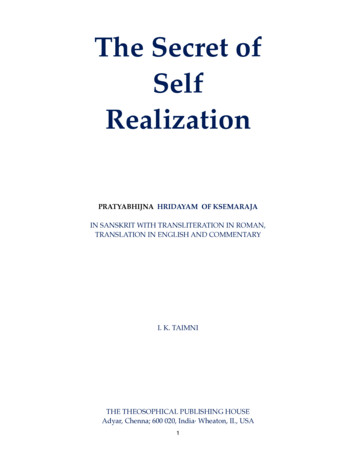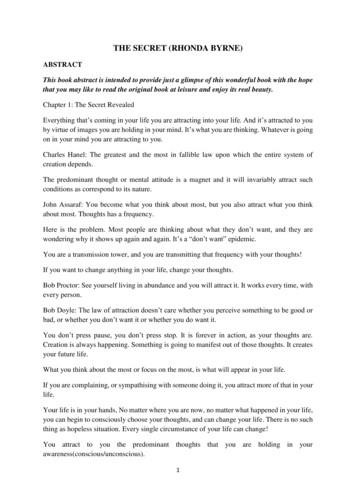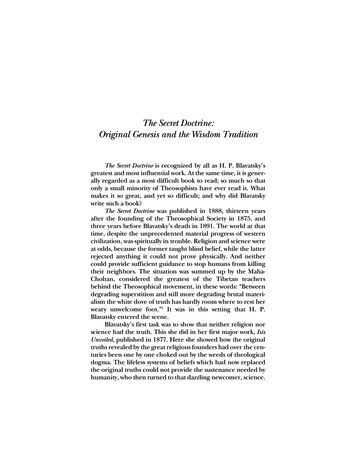
Transcription
The Secret ofSelfRealizationPRATYABHIJNA HRIDAYAM OF KSEMARAJAIN SANSKRIT WITH TRANSLITERATION IN ROMAN,TRANSLATION IN ENGLISH AND COMMENTARYI. K. TAIMNITHE THEOSOPHICAL PUBLISHING HOUSEAdyar, Chenna; 600 020, India· Wheaton, II., USA1
The Theosophical Publishing House, 1974First Edition 1974First Reprint 1979Second Reprint 1990Third Reprint 1997ISBN 81-7059-127-9 (Hard Cover)ISBN 81-7059-128-7 (Soft Cover)Printed at the Vasanta PressThe Theosophical SocietyAdyar, Chennai 600 020, India2
INTRODUCTIONThis eleventh century Sanskrit text of Kshemaraja epitomizes the teachings of the Kashmir Saivaphilosophy, and was meant to aid aspirants to higher consciousness who were untrained inintellectual and dialectical exercises.Dr Taimni's elucidatory translation adheres to this approach and, avoiding technicalities, guides thenon-specialist reader to the core of the illuminating truths presented in just twenty brief aphorisms.It shows that everyone can break through the limitations of normal consciousness and experience theinfinite joy and power of the supreme reality.3
PREFACEPratyabhijna Hridayam, although not well known, is one of the masterpieces of occult literature.To give the student some idea of the scope and philosophical grandeur of what is sought to beconsidered within the scope of only twenty aphorisms contained in this treatise, we may take first abird's-eye view of the panorama of inner realities which are hinted at in this valuable treatise.This will enable the student to appreciate more easily the value of this short treatise as a masterlyexposition, in an extremely condensed form, of the essential knowledge which an aspirant needs fortreading the path of practical occultism.And it will also enable him to develop the capacity of drawing out by his own mental effort andintuitive insight the vast stores of occult knowledge which are merely hinted at in the aphorisms.For this reason it is a book eminently suited for those who are learning the art of meditation so thatthey can dive deeper into the inner realms of knowledge and draw out from within what cannot beexpressed through the medium of language.In dealing with the aphorisms for our present purpose we may divide them into groups according asthey deal with particular aspects of the general problem which is the central theme of this book,namely Self-realization or ' recognition ' of our real spiritual nature by the methods of Yoga.It is obvious that if an aspirant is involved in this world with its illusions and limitations and has lostawareness of his divine nature as a result of this involvement, he should know the essential nature ofthis world in which he is involved if he is to understand and apply the necessary means for regaininghis freedom.It is not necessary for him to have a detailed knowledge of cosmogenesis or related philosophicalproblems for this purpose, but only that fundamental and essential knowledge regarding the natureof the universe which throws light on the manner of involvement and the means of liberation.The first three aphorisms of Pratyabhijna Hridayam therefore give in a masterly sweep ofphilosophical thought the origin and nature of the universe in a very condensed form, but so clearlystated that any aspirant can understand it easily.After dealing with the nature of the world in which the individual atma or the Monad is involved, theauthor proceeds to deal with the nature of the Monad who is involved, and whose liberation from theillusions and limitations of the world is the Object of Self-realization.Now, in considering the Monad and his liberation we have to distinguish between his eternal,spiritual nature and the ever-changing psychic mechanism in which he is involved and from whichhe has to free himself.4
Aphorism 4 gives an idea regarding this eternal and divine Monad hidden within the psychicmechanism and shows how he is related to the universal consciousness from which he is derived, onthe one hand, and to the psychic mechanism in which he is involved, on the other.What may require many chapters to explain by an ordinary scholar has been stated simply andtersely in a single aphorism which goes into the very heart of the matter and thus succeeds in giving awonderfully clear and true idea of what is sought to be conveyed to the reader.The secret of clear and concise exposition of any subject is to go into the very heart of the matter to becommunicated and state it simply and essentially.After pointing out the essential nature of atma in aphorism 4 the author proceeds to give in aphorism5 an idea of the essential nature of the mind or psychic mechanism in which the individual atma isimprisoned and through which he functions on the different planes of manifestation.Here again we see the same masterly statement of a profound occult truth of vital importance to theaspirant in a few words.According to this aphorism the mind is nothing but the spirit which has descended into the lowerplanes, has created the individual mental world by the differentiation of its centralized consciousnessand, by identifying itself with this world, has become involved and imprisoned within it.The profound significance of this ultimate relation between the pure Spirit and the individual mindwithin which it is imprisoned should be carefully noted because it points out a fundamental fact ofthe greatest importance to the candidate for Self-realization.This fact is that the individual mind is merely a derivative of the Spirit and has no existence apartfrom the Spirit.It is for this reason that it is possible, by the practice of Yoga, to make the mind disappear and revertto the state of Spirit from which it was derived.Of course, this relation of mind and Spirit is inherent in the occult doctrine that there is only OneReality in existence, but it requires a statement of the relation in such clear terms in order to bringhome to us its profound significance.In the centralization and differentiation of consciousness which leads to the involvement of the Spiritin matter, it is both knowledge and power which become enormously limited owing to the force ofmaya which deprives the individual atma of the awareness of its real nature, and thus involves it inthe illusions of the lower worlds.5
In Pratyabhijna Hridayam this limitation of knowledge and power is referred to separately, althoughit is the simultaneous limitation of both which is responsible for the involvement of the individual insamsara.The individual soul with its extremely limited and illusory knowledge is referred to as mayapramata inaphorism 6.This phrase means “a knower whose knowledge is limited and vitiated by maya or illusion”.The limitation of knowledge is so tremendous that the individual atma, whose consciousness isessentially one with universal consciousness and therefore embraces the whole universe, becomes theordinary individual soul running after all kinds of objects in the unreal world to satisfy its hunger forhappiness.In aphorism 4 the essential nature of the individual atma or the Monad and the psychic mechanism inwhich he is involved is indicated.Aphorism 7 goes into the same question again in order to throw further light on the subjective andobjective aspects of his nature.The atma in its subjective aspect is shown to be essentially one, but to function as dual, triple andquadruple in manifestation.The same atma in its objective aspect provides the paraphernalia of the manifested universe, and thiscomplementary aspect of its nature is referred to as prakriti in Hindu philosophy in contradistinctionto purusa the subjective self.This objective aspect of its nature is stated to be pentad and heptad.As this question has been discussed in the commentary on aphorism 7 we need not go into it here.Having defined and classified the subjective and objective aspects of Reality the author points out inaphorism 8 that the purpose of different systems of philosophy is merely to present an exposition ofthese aspects, different systems laying emphasis on different aspects.This is an important aphorism because it defines clearly the purpose of all philosophical thought, andindicates in which direction this thought should move if it is to serve this purpose instead ofmeandering into all kinds of irrelevant paths and sometimes degenerating into a futile andpurposeless exercise of the intellect for satisfying the intellectual curiosity of a small number ofpeople.6
If this view is recognized as sensible it will not only give a meaningful direction to philosophicalthought but also bring about philosophy in dynamic relationship with religion and science, and showthe necessity of adopting an integrated approach to all problems of human life.The centralization and differentiation of consciousness brings into existence the individual atmawhose knowledge is limited to such an extent by this process that he begins to behave like a deludedindividual lost in the jungle of worldly desires and experiences.But consciousness and power are correlatives and cannot be separated.So when knowledge is limited in this manner, power must be correspondingly limited at the sametime.Not only is it limited but its exercise is vitiated by the force of illusions in which the individualbecomes involved.How this exercise of divine power which flows through the individual becomes vitiated by ignoranceand the force of illusions has not been pointed out in aphorism 9 because the phenomenon is socommon and noticeable.But the aphorism does point out that this limitation of power leads to the piling up of all kinds ofeffects like karma which keep the individual atma tied down to the lower worlds.These effects cannot appear in the world of Reality in which knowledge and power are both infiniteand incorruptible.They can appear only in the world of the unreal where the power of the individual atma is limitedand is reduced to a state almost of impotence in the early stages of evolution.It is only when the spiritual nature of man becomes sufficiently unfolded that the divine powerhidden within his heart begins to descend through the center of his consciousness in increasingdegree and he is able to dissipate gradually these distorting and obscuring agents which keep himinvolved in the illusions and attractions of the lower worlds.This power continues to grow stronger and stronger until all the illusions and attachments whichimprison consciousness are burnt up and the deluded Monad attains liberation throughSelf-realization as pointed out in aphorism 15.Is there any outer indication that the ordinary individual, immersed in the attractions and pursuits ofthe lower worlds, is really a limited expression of the universal consciousness which is the source andbasis of the manifested universe?Aphorisms 10 and 11 attempt to answer this question.7
They point out that in spite of the tremendous limitations imposed on universal consciousness andpower when it is centralized, the individual, though deluded, continues to perform unconsciouslyand in a limited manner, the divine functions of the macrocosm, the Presiding Deity of a manifestedsystem.It is this fact which indicates to some extent his divine origin and the divine potentialities which arehidden within him.What these divine functions are and how they are performed by the macrocosm and the microcosmhas been explained in the commentaries on these two aphorisms and need not be discussed here.The limitations of universal consciousness when it is centralized and expressed through an individualcenter of consciousness deprives the individual of the awareness of his divine nature, and it is thedelusion caused by this privation which makes him run after all kinds of worldly objects and pursuitsin a futile search for happiness.How does the simultaneous limitation of divine power and the delusion caused by maya affect thebehavior of such an individual?Aphorism 12 attempts to throw some light on this question.According to it, under this delusion the individual begins to regard the divine power flowing throughhis vehicles as his personal power, which belongs to him and which he is entitled to exercise in anyway be likes.It is this attitude which is really responsible for the almost universal misuse of power in the world.Instead of considering himself as a mere trustee of that power and using it properly, the individualwho has no sense of discrimination, begins to use it in an irresponsible manner and even to misuse itfor gaining extremely selfish and sometimes nefarious ends.The blind pursuit of power and constant effort to seize it whenever and wherever possible is thesurest indication of the fact that the individual is grossly involved in the illusions of the world, andthe misuse of that power when it is seized in this manner is therefore inevitable.For the individual who has risen above the illusions of the world, even to a small extent, power hasno attraction and he does not desire or seek it, because it means added responsibilities which must bedischarged most carefully and scrupulously.But when it comes to him naturally in the performance of his duties he does not reject it but uses itproperly as a trustee of the Divine Life which has placed that power in his hands.8
The right use of power has to be learnt by every aspirant who wants to become a conscious agent ofthe Divine Life in the fulfillment of the Divine Plan.It is a part of the self-discipline undertaken to attain Self-realization, and its technique is generallyreferred to as niskamakarma.In the aphorisms discussed above the centralization of Reality, and the limitation of consciousnessand power which results from the loss of awareness of our real nature were dealt with.The question arises: Is this process reversible?In other words, is it possible to decentralize consciousness, as it were, and, by regaining awareness ofour real nature, transcend the illusions and limitations in which we are involved?Aphorism 13 answers this question in the affirmative and also gives the general principle underlyingthe method of bringing this about.In order to understand the significance of this method it is necessary to remember that whenconsciousness gets involved in the lower worlds, three things happen:(1) Consciousness or citi descends from its pure integrated state in the world of Reality into the lowerdifferentiated state of the worlds of the mind or cittam;(2) The mind becomes outward-turned in the process;(3) There is loss of awareness of his real nature in the individual.It is obvious therefore that if Self-realization is to take place there should be a reversal of all thesethree processes.It is this fact which aphorism 13 states in a terse form.The same idea is expressed in a somewhat different language in aphorisms II - IO and 11 of the YogaSutras.Lest the student may imagine that this reversal of the process of involution aimed at in the practice ofYoga is something unnatural, imposed artificially from without, aphorism 14 points out clearly that itis the involution of the consciousness of the Monad in the lower worlds which is unnatural becausehe belongs to the world of Reality, and is established in his innermost nature in the very heart of citand ananda.It is this fact which accounts for the universal urge to regain consciously or unconsciously the divineheritage which he has lost, in being involved in the worlds of manifestation.9
The Reality which is hidden within his heart, even in the state of bondage, is like a fire whichautomatically starts burning everything which is unreal in his life and in the process gains greaterand greater intensity.When this fire, which expresses itself as spiritual discrimination, reaches the required intensity itbums down the whole structure of the unreal and illusory world created by the mind, and thenshines unobstructed in the heart of the enlightened individual in its divine splendor, as pointed out inaphorism 15.After dealing with the mechanism of involvement of the Monad and the general method by whichthis process can be reversed and the Monad freed from the illusions of the lower worlds by means ofSelf-realization, the author proceeds to give some indication in aphorism 16 of the state ofenlightenment gained in this manner.There are three points to be noted in this aphorism.The first refers to the essential nature of the Monad who is divine and therefore shares thesat-cit-ananda nature of Divinity.Why only two of these three aspects of Divinity, cit and ananda, have been referred to in this aphorismhas been made clear in the commentary on the aphorism.The second point to be noted in studying this aphorism is that in the state of Self-realization, themechanism which consciousness has evolved on the lower planes and through which it functionsremains intact and the consciousness continues to function through it as before.What is the difference, then, between the state before and after Self-realization?The difference lies in perceiving this mechanism and its functions as essentially of the same nature asconsciousness and not separate and independent of it, as pointed out in the last aphorism.It is seen now in the light of that Reality and as part of that Reality which is One, Whole andIndivisible - and therefore does not obscure the awareness of that Reality which embraces andcontains everything in the universe within itself.This fascinating concept has been dealt with more thoroughly in some of the aphorisms of theSiva-Sutra.The third point to note in this aphorism is that it is the attainment of this supreme state, in whicheverything, including the mind, vehicles, and activities of the atma are seen as different aspects andexpressions of the One Reality, which liberates the Monad from the bondage of the lower worlds andenables him to function in these as a free individual when and if this becomes necessary.10
This state of enlightenment not only liberates him from the bondage, limitations and illusions of thelower worlds - but liberates him permanently and irreversibly if the process of Self-realization hasbeen once completed.It is necessary to point out this fact because this process is progressive in nature and the final andirreversible state can be reached only through a series of intermediate states of partial and temporaryglimpses of Reality.But if the necessary means hinted at in aphorism 16 of Pratyabhijna Hridayam and aphorism IIl - 24of the Siva-Sutra are adopted then the process of enlightenment is completed and the individualbecomes permanently and irreversibly established in the world of Reality.It is the attainment of this state of awareness of Reality in the midst of so-called unreal objects whichis referred to as jivanmukti-dardhyam in this aphorism.But the freedom from the necessity of rebirth is not the final goal of Self-realization.There is one more hurdle to be crossed in order to make this process complete and irreversible.This ultimate stage is referred to in aphorism 19 of this treatise and aphorism III - 25 of the Siva-Sutra.It is also hinted at in some aphorisms of the Yoga-Sutras, c.g., III - 35, III - 54 and III - 55.How is this state which has been referred to in the preceding aphorism to be attained?Aphorism 17 gives the answer in a statement of five words which is again a masterpiece of brevityand clear expression.All students of the occult doctrine are familiar with the idea that the whole of Reality in all its infiniteaspects is present within the center of human consciousness in layer after layer of unfathomabledepths and unimaginable splendors, and Self-realization is merely a means of unfolding andunveiling these realities hidden within the center.This unfoldment is a process of progressive and never-ending changes in the mind and consciousnessof the individual, bringing into the field of consciousness these real states one after another.But as far as human evolution is concerned there is a definite stage in this unfoldment which resultsin the attainment of the sat-cit-ananda nature of Divinity.It is this state of enlightenment which is called Self-realization, and sets the individual free from theillusions and limitations of the unreal worlds.11
Aphorism 18 enumerates some of the techniques utilized in the practice of yoga for the unfoldmentof the individual center of consciousness.The whole science of yoga deals with these techniques of various kinds and different effectiveness,and those given in aphorism 18 should be considered merely of a representative character.It is not easy to understand the nature of these techniques which are generally put in a veiledlanguage and can be learnt by practical experience imparted by those who are masters of thatparticular branch of yoga.But a careful and earnest examination of these will show the student how they can serve the purposeof unfolding the center of consciousness which is referred to as madhyavikasa in aphorism 17.The importance and significance of aphorism 19 does not lie solely in the fact that it gives in a verygraphic form the method of attaining nityodita-samadhi, the highest kind of samadhi which liberates theindividual completely and permanently from the illusions and limitations of the lower worlds.Its real significance which is of far greater importance from the practical point of view is that it pointsout clearly the fact that mere attainment of cit-ananda, which gives freedom from the necessity ofrebirth, is not the ultimate objective of yoga.It is nityodita-samadhi which is the ultimate objective because it is this which permanently andirreversibly liberates the individual from the bondage of samsara.The full Significance of these practices which are undertaken in the last and highest stage of yoga isgenerally missed by the ordinary student, and this leads to some confusion of ideas relating to thenature and purpose of these practices in the process of Self-realization.The importance of these practices and their indispensable nature are shown by the fact that they arealso referred to in slightly different language in the other two classics of yogic literature - Yoga- Sutrasand Siva-Sutra.In the Yoga-Sutras nityodita-samadhi is referred to as dharmamegha-samadhi in aphorism IV - 29, and inthe Siva-Sutra it is referred to as Sivatulya in aphorism III - 25.The last aphorism of Pratyabhijna Hridayam naturally gives the result of attaining nityodita-samadhiwhich is referred to as kaivalya in the Yoga-Sutras.When the individual is established permanently in the world of Reality, a new state of consciousness,vista of activities, and mode of unfoldment of consciousness, all three mysterious and beyond thescope of the human intellect, open out before the liberated adept.This aphorism throws some light on these questions, though what is given is in the form of hints only.12
But even these cryptic statements will provide the intuitive and mature students with someknowledge of the most profound nature, and fill in many gaps in the occult doctrine on which hardlyany information is available.It is interesting to compare the last aphorism of Pratyabhijna Hridayam, pregnant with ideas ofprofound significance, with the last aphorism of the Yoga-Sutras which hardly gives any new idea ofvalue to the student of the occult doctrine.13
citih - The ultimate reality in its aspect of cit or as universal consciousnesssvatantra - depending completely upon itself and nothing external, for there is nothing in existencebesides itvisva - the manifested universesiddhi - manifesting the universe and bringing it to its appointed consummationhetuh - (is the) instrumental cause.“The ultimate reality in its cit aspect or as universal consciousness, being absolutely independentand self-contained, is the ultimate cause of manifestation, and bringing a manifested system to itsappointed consummation.”In order to understand the deeper significance of this aphorism it is necessary to recall the occultdoctrine that the manifested universe is a periodical appearance of a mental phenomenon whichcomes out from the unmanifest state of Reality and then becomes merged or laya in the same Realityafter running its course.It is not a question of ' creation ' in the ordinary sense, but of projection outside from within, and thenwithdrawal within from without.As a matter of fact there can be no ' within ' or ' without ' in a Reality which, being an integrated state,is all-embracing - and outside which nothing can exist.But we use these words because we try to consider these things from below, from the lowest planes ofmanifestation, and the manifested universe appears to come out of the Unmanifest which we cannotvisualize or understand in the real sense.The question arises:Is the underlying Reality of the universe out of which the manifested universe seems to appearsvatantra, self-determined, or bound by a rigid determinism determined by the laws of nature?This is not the place to discuss in detail this interesting philosophical question, but it is clear thataccording to this aphorism the Reality, in its innermost nature, is self-determined and free to manifest1
the universe according to its will, though the creation, maintenance and reabsorption of the universe,which is implied in the Sanskrit word siddhi, and takes place according to laws which are inherent inthe manifested universe and must therefore be inherent also in the Reality itself.It is this fact which accounts for the orderly nature of the cosmos which otherwise would be a chaos.If this nature and mode of manifestation is inherent in Divine Nature and manifestation takes placeaccording to this inherent nature, this does imply a certain degree of predetermination, but this kindof predetermination can coexist with self-determination in the same way as the existence of rigidnatural laws can coexist with the freedom to utilize those laws to achieve results of our own choice.For example, in spite of the law of gravitation we can send spacecraft into space, and when aspacecraft goes beyond a certain distance we find it becomes independent of gravitation.In the same way consciousness exists in several layers depending upon the density of the ' matter 'through which it functions.The more it descends down into the denser levels of manifestation the more restricted it becomes inits freedom and power.But it can recede within into its deeper layers, and as it recedes, its freedom of will grows - and at thedeepest level becomes absolute.Even on the spiritual planes its freedom is much greater and grows steadily as the Center of Reality isapproached.It will be seen therefore that it is this highest state of reality which is svatantra, and not its expressionsin prakriti or Nature.The Monad, being an expression of the ultimate reality, is free in his innermost nature, but onbecoming involved in manifestation his freedom becomes restricted - the lower the level to which hedescends the greater the restriction.This process of progressive restriction is reversed gradually on the evolution of his consciousness,and the inherent freedom is gained again when he regains his full awareness of the reality in whichhe is centered.It is the regaining of this awareness through pratyabhijna or ' recognition ' of his real nature whichSelf-realization aims at, and which leads to the absolute freedom implied in liberation or jivanmukti.The deep significance of the word siddhi ought to be noted.It implies the whole process of manifestation from the beginning to the end.2
According to the occult doctrine the manifested universe not only appears periodically but it runs itscourse according to a plan which is present in the Divine Mind, and unfolds according to the divineideation which takes place in the Divine Mind.It is only when the consciousness of an individual is able to contact the Divine Mind that it becomesaware of the working of the Divine Mind, and knows the splendor of the inner realities which arehidden on the spiritual planes behind the apparently purposeless and chaotic working of the physicaluniverse.Science, seeing only this outer shell, and being unaware of the existence of these inner realities,naturally sees the universe only as ' a fortuitous concourse of atoms ', or a chaotic expression ofenergy in multifarious forms.Its theories about the nature and origin of the universe are therefore bound to be wrong because theyare based upon extremely limited data and uncertain and arbitrary assumptions.It is interesting to note that recent researches in different fields of science have demolished the idea ofpredetermination in its rigid form, and at least some scientists recognize the possibility not only ofthere being mind and consciousness behind the working of nature, but this mind being free toinfluence the course of evolution in the universe.But as this question has been dealt with thoroughly in Science and Occultism, it is not necessary todiscuss it here.The use of the word citi for the Reality which is the basis of the manifested universe requires someexplanation.This word has been used only once in the last aphorism of the Yoga Sutras but it occurs frequently inthe Pratyabhijna Hridayam.The word is derived from cit, one of the three aspects of Reality referred to in Sanskrit assat-cit-ananda.As has been shown in other contexts the cit aspect is the root of the Mind principle, and Mind is thebasis of manifestation.So when we want to bring out that aspect of the ultimate reality which is the cause and instrument ofmanifestation, we use the word citi in contradistinction to the sat aspect which remains unmanifest, inthe background, and is the root of the principle of divine will which finds expression in divine power.When Siva, whose essential nature is sat, the ultimate and the whole truth, wills that the universeshall manifest, the cit aspect comes into play, the whole drama of manifestation begins and continuesuntil the universe is reabsorbed into his conscio
The Theosophical Society Adyar, Chennai 600 020, India 2. INTRODUCTION This eleventh century Sanskrit text of Kshemaraja epitomizes the teachings of the Kashmir Saiva philosophy, and was meant to aid aspirants to higher consciousness who were untrained in intellectual and dialectical exercises.











